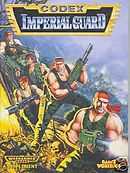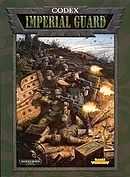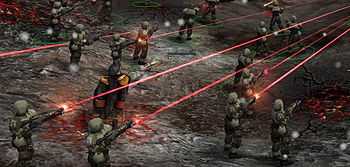Imperial Guard (Warhammer 40,000)
The Imperial Guard, now known as the "Astra Militarum", are a specific army or faction in the Warhammer 40,000 and Epic tabletop games and universe. The army itself is characterised by being capable of fielding a multitude of lightly armoured, average infantry in combination with some of the toughest and most powerful tanks in the game.[1] In the game universe, the Imperial Guard is a colossal military organisation consisting of trillions of men and women supported by millions of tanks each from thousands of different worlds and systems within the Imperium of Man.[2]
The Imperial Guard was first introduced to the game in White Dwarf 109, January 1989. In April 2014 a new codex was released for the 6th Edition of the game, along with a number of new plastic kits. Such models included plastic versions of Ogryn's and the re-branding of Stormtroopers becoming Scions which had previously been metal. A plastic kit of the Hydra (previously a Forge World model) became also available. Along with the new rules and kits released with the 6th Edition rulebook, The Imperial Guard had a name change to the Astra Militarum.
Overview
The Imperial Guard (previously the Imperial Army) is a colossal fictional military organization, consisting of many hundreds of thousands of armies throughout the Imperium, and forming the vast bulk of the Imperium's military machine. Unlike the Space Marines, who are an elite unit that rely upon precision strikes against the enemy's critical assets to carry the day, the Imperial Guard relies on massed assaults made up of endless waves of infantry and armor to achieve victory. "If a Space Marine assault is likened to a surgeon`s scalpel, the Imperial Guard assault is likened to a sledgehammer blow" It is this battlefield strategy that has earned the organization the moniker "The Sledgehammer of the Emperor". It also earns the Guard the reputation as a meatgrinder, whose commanders are more than willing to spend their soldiers' lives for the smallest of gains or in the most suicidal defensive actions.
Each Imperial Guard regiment is raised from a single world and numbers between 500 and 750,000 fighting soldiers, supported by a huge array of light and heavy armored vehicles. Each regiment also has its own entourage, consisting of support staff, camp followers, suppliers, tech-priests, doctors, religious leaders and the like. When thousands of regiments are grouped up into large fighting forces, they are issued far larger assets such as theatre- or even planetary-scale artillery, thousands of super-heavy tanks regiments, and even hundred strong groups of Cohorts of Praetorian-class landships that dwarf the Leviathan command vehicles from thousands of Munitorium armory, fortress, and staging worlds. Although a player may field a mixed force of these armor, artillery, and infantry units on the table-top, in the game universe, the composition of any one regiment is fairly uniform; that is, an infantry regiment will contain thousands of foot soldiers with only a minimal number of support vehicles and an armored regiment will consist of little else save its tanks. This policy was put in place by the Imperium to prevent, or at least minimize the damage from, large scale mutinies in the wake of the Horus Heresy, as no one regiment constitutes a complete, self-sufficient fighting force in its own right.
Regiments are drawn from all types of planets of the Imperium from Fortress worlds such as Cadia, where the entire populace is raised under arms from birth, to Feral and Medieval worlds, and the contributions of some planets over the ten thousand years of the Imperium run into the billions of regiments, if not more. The Imperial Guard are constantly at war, freeing worlds from Chaotic or alien influence, or defending them from the same.
The Imperial Guard rely upon the Imperial Navy for transport to and from war zones. The Imperium's naval and ground forces are kept strictly separate such that a mutinous general will not have access to an integrated military machine. That was not the case with the pre-Horus Heresy Imperial Army, which had no such strict distinction.
Gameplay


History of the Imperial Guard as an Army
The first edition of Warhammer 40,000 included rules for a force known as the "Army". Later their name was changed to "Imperial Guard" and then as of 7th edition "Astra Militarum". The Imperial Guard make up the back bone of the Imperium.
The Imperial Guard was initially bound by a series of rules, published in the Warhammer 40,000 Compendium, relating to its command structure. Squads of units formed platoons under a command squad. Units that were separated from the command squad were more limited in action. The initial Imperial Guard army could include, besides the basic squads, Rough Riders (a form of Cavalry), penal units, human bombs, abhumans and robots. Several vehicles were available; motorcycles with an optional side-car, Jet cycles (a form of jet propelled motorbike), grav attack vehicles (armoured fighting vehicles utilising anti gravity for propulsion), Land Raiders (armoured fighting vehicles with a similar design to the British Mark I tank), Rhinos (an Armoured personnel carrier), Sentinels (a two-legged walker, similar to an AT-ST), Predators (a Tank) and Land Speeders (a two-man hover vehicle, cf. Landspeeder).[3]
The first incarnation of the Imperial Guard as a fully supported army was in 1995, with the release of the Codex: Imperial Guard sourcebook for the second edition of Warhammer 40,000. This was the first time that the army itself had specific army rules collected in their own sourcebook.[4] With the release of the third edition of the game, almost all the Warhammer 40,000 armies eventually had new codices compatible with the new edition. In line with this, Codex: Imperial Guard was released in 1999,[5] followed by Codex: Catachans in 2001. This was a smaller sourcebook (or mini-dex/mini-codex) that was meant to be used in conjunction with the "parent" Codex: Imperial Guard. The mini-dex itself provided even more specific rules for fielding one of the more popular Imperial Guard sub-armies, the Catachan Jungle Fighters, for which plastic models were available.[6] In 2003, Games Workshop conducted the Eye of Terror worldwide campaign and released a corresponding sourcebook, Codex: Eye of Terror. This campaign sourcebook contained various rules, including a specific army list for another one of the Imperial Guard's notable sub-armies, the Cadian Shock Troops.[7] Soon after the campaign ended, the changes in the Cadian Shock Troops army list were integrated into the Imperial Guard rules, and Games Workshop released a second, revamped version of Codex: Imperial Guard.[1] Following various rumors, White Dwarf 351 confirmed that an updated Imperial Guard codex was being released, along with new rules and miniatures (including the Valkyrie airborne assault carrier, a new Cadian and Catachan command squad and a new sentinel) and was released on May 2, 2009.
Overview
Individual guardsmen are weak and have low point-costs, thus Imperial Guard armies are usually rather large (a full guard platoon can boast up to 132 models, not counting independent characters, per troops choice). In addition, they have access to various vehicles, such as the Leman Russ main battle tank, Basilisk mobile artillery, Chimera armored troop transport and the Sentinel walker. Because they require so many units, an Imperial Guard army can be expensive and time-consuming to assemble and paint. In regards to their weak willed infantry the guardsmen rely on their unique sources of tanks and fire support. These mechanized vehicles vary from light armored transportation to heavily fortified tanks and artillery machines. All vehicles are designed and built by the imperial guard engineers. These engineers were the original builders of the manufactorium, this means they were given the advantage to build structures faster and to also design effective vehicles. Without the extra support of tanks and war machines the guardsmen are not able to win a fight.
In the latest Codex, the Imperial Guard "doctrines" were removed, replaced by the "orders" system. Units designated by the "order" must be in a specific distance radius from either a Platoon Officer or a HQ Officer. Benefits are given if both the officer's unit and the squad receiving the order have vox-casters - in-universe term for radio.
In addition to humans, the Imperial Guard also contains several types of abhumans — species evolved from humans that differ markedly from the norm. The two species most commonly found are the Ogryns (the counterpart of the Warhammer Fantasy setting ogres) whose superhuman strength makes them excellent close combat fighters and the Ratlings (resembling halflings/hobbits) who function as expert snipers.
One of the more distinctive aspects of the Imperial Guard army is its Commissars. They are represented as akin to the ruthless, political commissars of the former Soviet Union. The Imperial Commissar, as described by many Warhammer novelists, is given complete jurisdiction to judge the actions of any trooper or officer and to act accordingly. This includes summary execution of units who display disobedience or cowardice (in gameplay, this is a useful function that boosts the morale of wavering units and prevents possessed psykers from turning on their comrades). Understandably, they are much hated by the guardsmen they serve with. Many novels hint that a good portion of the Commissars slain in battle are "accidentally" hit by friendly fire; the 4th-Edition Codex for the notoriously anti-authoritarian Catachan regiments of the Imperial Guard includes the "Oops, Sorry Sir" rule that gives Commissar models included in a Catachan army a 1-in-6 chance of having been killed - or more appropriately, fragged - before the game begins. There are also hints that some Commissars have taken to the tactic of inspiring troops by heroic example, hoping to emulate the "heroic" Commissar Ciaphas Cain.
Another unique aspect of the Imperial Guard is that the models for the regiments of different worlds are physically distinct, rather than the same models with different paint schemes like the other armies (save the Space Marines where the Blood Angels, Dark Angels, Space Wolves, and Grey Knights Chapters all have models specific to them which other Chapters may not field and as such are considered separate armies). For example, the models for the Cadian Shock Troops resemble the soldiers of the Mobile Infantry as seen in the movie Starship Troopers and the Catachan Jungle Fighters appear in the stripped down uniforms as worn by American soldiers in the Vietnam War and as seen in movies based around that conflict such as Rambo - a look befitting the inhabitants of a jungle world where everything is trying to kill them.
As a single platoon contains several squads, and each squad has options for taking special and heavy weapons, a single troops choice can take a staggering amount of said weapons: a fully loaded platoon may take up to 11 special weapons and 20 heavy weapons in a single troops choice, while most other armies can only take one of each. This, combined with the heavy firepower of Guard vehicles, produces an army that is primarily geared toward firepower. To offset this and create a proper balance to the game, the designers gave the average Imperial Guardsman a low armor save of 5+ and only an average value of 3 for their Weapon Skill, Strength, Toughness, and Initiative scores. This means that should an enemy withstand the blistering hail of weapons fire and close the distance to assault, the Guardsmen will more than likely be torn apart in the ensuing melee.
Some of the major strengths of the Imperial Guard army are their vehicles. From the fragile Sentinel to the devastatingly destructive Leman Russ Demolisher, and many of its new variants previously shown in the Imperial Armour books by Forge World were released in the new Codex, the vehicles of the Imperial Guard can significantly add to their effectiveness as an army. The Imperial Guard are said to have the best tanks in the game. Although individual tanks from other armies (such as the Necrons) may sport more firepower and/or armor than those of the Imperial Guard, the Guard has, overall, the most powerful armored force (or, at least, the most varied). New plastic kits for the Hellhound flamethrower tank and the Leman Russ Demolisher have been released, while new plastic kits for the Basilisk mobile artillery and the Chimera armored troop transport were released with the expansion Battle Missions.
The New Order Of The Guard
Released in 2014,the Militarum Tempestus are a supplemental book for the Astra Militarum. These "Storm Troopers" are seasoned killers from birth, recruited for their extreme ferocity and discipline in combat and off of it. They are taught to execute any order made by a Commissar, no matter if it is killing a friend they had made, or sending their squad against impossible odds. Unlike the normal guard, Tempestus Scions are the troop choice of this army. They are more expensive than the soldiers of the guard, but are equipped with the finest gear in the galaxy. They all come with "Hot Shot" Lasguns, Carapace armor, and are all lead by a Tempestor. An elite rapid response force within the Imperium intended to bypass the Administratum's miles of red tape, their highly trained squads and regiments are sent for the toughest of assaults and surgical strikes. When the Space Marines aren't available, Inquisition has no answers and the Last Chancers are nowhere to be seen, the Tempestus are the forces often used. They have heavier weapons and armor than their Guardsman counterparts.
Video games

The Imperial Guard make several appearances in many of the video games that occur in the Warhammer 40,000 universe.
The Imperial Guard make a guest appearance in the single player campaign of Warhammer 40,000: Dawn of War led by Colonel Carus Brom as NPCs and playable units in some missions. They have since been expanded into a playable faction in the game's expansion packs:
- In Winter Assault, the Guard is represented by the 412th Cadian Regiment under the command of General Sturnn in the Order Campaign.[8]
- In Dark Crusade, the 1st Kronus regiment, a.k.a. "The Liberators", represents the faction, led by Governor-Militant Lukas Alexander with their home territory based out of "Victory Bay." [9]
- In Soulstorm, the faction is portrayed as the 252nd Kauravan Conservator Regiment, under Governor-General Vance Stubbs; their primary base of operations is located in the Dussala Precinct on Kaurava I which manufactures the Imperial Guard's imposing Baneblade super-heavy tank.
The Imperial Guard were part of the Imperium's force in Final Liberation: Warhammer Epic 40,000, the other two parts consisting of the Space Marines and the Adeptus Mechanicus Titan legions.[10]
The Imperial Guard also make appearances as opposition in the Warhammer 40,000: Fire Warrior first-person shooter. Among the possible opponents, there are lasgun- and autogun-wielding guardsmen, officers with chainswords and a Valkrie Dropship as a boss.[11]
The Imperial Guard has also made an appearance in the computer game Warhammer 40,000: Rites of War, usually used alongside Space Marine forces (much like in the Final Liberation).
Much like in the original Dawn of War the Imperial Guard (more specifically stormtroopers and regular guardsmen squads) make a supporting appearance as NPCs in Warhammer 40,000: Dawn of War II during several campaign battles, including the ending mission against the Tyranids. They also appeared in its expansion, Chaos Rising, with some guardsmen becoming traitorous and pledging their loyalties to Chaos in the early missions on Aurelia. They are replaced by Chaos cultists as enemies during the middle and ending sections of the campaign, while also serving as allies on selected missions in the campaign.
In Warhammer 40,000: Dawn of War II - Retribution, the Imperial Guard have become a fully playable race and are most dangerous when they field a large amount of tanks or a huge horde of infantry.
In Warhammer 40,000: Space Marine, the Cadian 203rd regiment (so battered up it is under the command of a second lieutenant) is trying to survive on Graia as the player's Ultramarines squad drops in. Guardsmen serve as NPCs throughout the game, and both the Guard and the player provide mutual support in terms of combat, navigation and air transport.
Bibliography
- Chambers, Andy; Haines, Pete, and Hoare, Andy (2003). Warhammer 40,000 Codex: Imperial Guard (3rd Edition ed.). Nottingham: Games Workshop. ISBN 978-1-84154-410-6.
- Johnson, Jervis (2001). Warhammer 40,000 Codex: Catachans. Nottingham: Games Workshop. ISBN 978-1-84154-016-0.
- Priestley, Rick; Ansell, Bryan. Stillman, Nigel. Davis, Graeme. Knifton, Pete. Weeds, Ivan. Brunton, Mike. Warwick, Andy. Norton, Derrick. (1989). Warhammer 40,000 Compendium (1st ed.). Nottingham: Games Workshop. ISBN 1-869893-71-9.
- Imperial Guard Homepage from the UK Games Workshop website. URL accessed on 9 January 2006.
- Haines, Pete. "Chapter Approved – Rolling Thunder: Armoured Companies Army List" (PDF). Games Workshop. Retrieved 2007-08-12.
See also
- Vehicles of the Imperial Guard (Warhammer 40,000)
References
- ↑ 1.0 1.1 Chambers, Andy; Haines, Pete, and Hoare, Andy (2003). Codex: Imperial Guard (2nd release) (3rd Edition ed.). Nottingham: Games Workshop. ISBN 978-1-84154-410-6.
- ↑ Priestley, Rick (1998). Warhammer 40,000 (3rd Edition ed.). Nottingham: Games Workshop. ISBN 978-1-84154-000-9.
- ↑ Priestley, Rick; et al. (1989). Warhammer 40,000 Compendium (1st ed.). Nottingham: Games Workshop. ISBN 1-869893-71-9.
- ↑ Priestley, Rick (1995). Codex: Imperial Guard (2nd Edition ed.). Nottingham: Games Workshop. ISBN 978-1-872372-92-1.
- ↑ Johnson, Jervis; Gavin Thorpe (1999). Codex: Imperial Guard (3rd Edition ed.). Nottingham: Games Workshop. ISBN 978-1-869893-52-1.
- ↑ Johnson, Jervis (2001). Codex: Catachans (3rd Edition ed.). Nottingham: Games Workshop. ISBN 978-1-84154-016-0.
- ↑ Chambers, Andy; Hoare, Andy, and Kelly, Phil (2003). Codex: Eye of Terror (3rd Edition ed.). Nottingham: Games Workshop. ISBN 978-1-84154-398-7.
- ↑ Relic Entertainment (2005-09-21). "Warhammer 40,000: Dawn of War - Winter Assault". Windows (v1.40). THQ.
- ↑ Relic Entertainment (2006-10-09). "Warhammer 40,000: Dawn of War - Dark Crusade". Windows (v1.0). THQ.
- ↑ Holistic Design, Inc. (1997-11-30). "Final Liberation: Warhammer Epic 40,000". Windows/DOS (v1.0). Strategic Simulations, Inc.
- ↑ THQ (September 2003). "Warhammer 40,000: Fire Warrior". Microsoft Windows/PlayStation 2. KUJI.
| ||||||||||||||||||||||||||||||